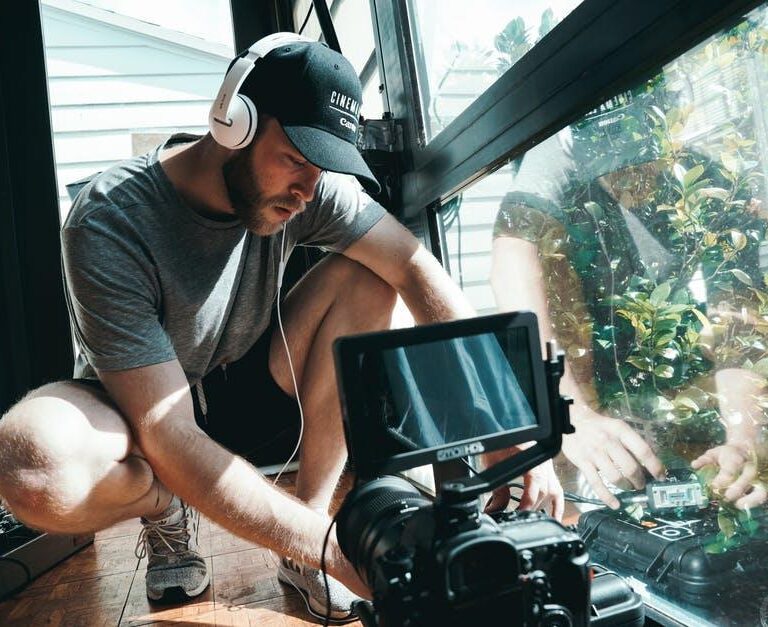Take a moment and think about the ads that you remember from at least a year ago.
What do these ads have in common? If you’re like 50% of people in North America, these ads have some element of humor.
Humor in advertising is not a new concept. People have known that humor works since the beginning of time. Okay, maybe not, but advertisers do know that humor in advertising proves effective when done well.
Why does comedy work so well? This comes down to what you want your advertising efforts to do.
Why Does Humor in Advertising Work?
Ads with humor have 32% more engagement than non-humorous ads. This concept works best with brand-building, but it can also prove effective to sell products and services.
That’s because advertising comes down to telling a story. Humor helps you move your brand story along by connecting with your audience.
Comedy Advertisement – A Quick Attention Grabber
Consumers make a decision about your brand or product within seconds. This means you need to use shorter ads that grab their attention quickly.
Videos that last no more than 30 seconds get the most attention. This means you want to create a connection quickly.
You want people to see your brand as relatable. Humor offers a quick way to show your personal side.
A Funny Ad Creates Positive Emotions
Since advertising comes down to storytelling, this means you need to create an emotional connection with your audience. You don’t want just any emotional connection though. You’ll get the most out of your ads if you create a positive emotional connection.
You want people to have a good feeling about your brand or products. You want them to connect you to things that make them happy. Well, humor makes people happy.
If you can reach them with humor, they’ll remember you as a brand that made them smile. The trick is to hit the right note of humor so you don’t overwhelm the message.
Using Humor Catches People Off Guard
We all know that online audiences find ads annoying. While they understand the need for ads, they avoid them as much as possible.
If you add an element of humor to your ads, especially early on, you have the potential to catch them off guard. Your target audience is more willing to stick around if they come across something that stands out from the normal ads that pop up.
This element of humor takes the sting out of the ad. People can forget they’re watching an ad if they find it interesting.
Humor also ads a level of balance. If you’re sharing something that people normally find boring or common, humor can balance that problem. You can go from boring to memorable.
Positive Connection Leads to a Memorable Brand
People remember jokes. They talk about the things they find funny. They hold on to these humorous memories. If you can hit your audience in the funny bone, they’ll continue to think about you and your brand.
Think about some of those ads people talked about for months afterward. The Old Spice commercial with the manly man or more recently the “she shed” commercial from State Farm.
People laughed at these commercials, and they talked about them often. More importantly, people remembered the brands advertised in these commercials.
Humor Builds Community
When people can share a laugh together, they feel closer to each other. Research backs up that humor brings people closer together.
Laughter makes people feel more connected to the person that made them laugh. It also makes them feel closer to the people they can share the joke with. This builds a natural community around your brand.
People want to share that laughter. That means people will bring others into the community by sharing the joke with others around them.
Humor Has the Best Potential to Go Viral
People’s desire to share humor also plays out on social media platforms. The videos that get the most views and shares are funny videos.
If you look at the trending videos on any platform, you’ll see that the top videos are the funny ones. This means well-done funny ads have the potential for viral-level social shares.
What better way to get the word out than letting others get your ad in front of new eyes? If you add that humor element, you have the potential for effective commercials with less work on your side to get them seen.
Humor Balances the Advertisement Field
It’s difficult to compete with those big names out there when it comes to creating brand recognition. These brands have more money than small businesses to spend on their marketing strategies.
The good news is, you don’t need a large budget if you can create a memorable ad. Humor gives this balancing effect to marketing tactics.
Humor gives small businesses a way to catch attention no matter how small the advertising budget. You have the opportunity to reach people on a competitive level if you know what you’re doing.
How to Create Effective Commercials Using Humor
While humor offers a competitive edge, it can also blow up in your face if you don’t use humor in advertising the right way. You need to know what people will respond to. You also know how to balance emotional connection with brand awareness.
Stay on Message
Humor for humor’s sake will not provide lasting brand recognition. Remember, you’re telling a story about your brand. Your brand needs to remain the protagonist in the story.
Any humorous elements you include in your advertisement efforts need to fit in with the brand story. These elements need to add to an understanding of who you are and what you offer.
A good example of humor going off message comes from PETA. They had a billboard asking people to save the whales by going vegetarian with a picture of an overweight woman. This ad got into fat shaming, which proves offensive and has nothing to do with PETA’s message.
Know Your Audience
Humor plays out differently depending on your demographic. This remains true for different ages, sexes, and even different cultures.
For instance, while people in North America laugh at sarcasm, this doesn’t play out well in China. You need to know your audience to understand what type of humor they’ll respond well to.
Before you create an ad, ask yourself who you want to reach with that ad. Do your research to understand what that target audience reliably responds to. Also, make sure you know what doesn’t play well.
Avoid the Raunchy and Offensive
Even if you know your target audience will respond to raunchy or offensive humor, you should still avoid including it in your ads. Others besides your target audience will have exposure to your ads.
If you offend too many people, it won’t matter if you reached a small group. Avoid ads that objectify and make light of serious subjects. You’ll likely lose even the people that find it funny due to the backlash.
Keep It Subtle
Sometimes hitting people over the head with funny messages can work. More often than not though, you’ll lose the overall message with forced humor.
Make sure humor elements blend with the ad message. The Twitter battles between Wendy’s and Burger King give a good example of this subtle humor. They poke fun at each other while promoting their different food offers. People have responded well to these battles and the companies had the chance to create more personal connections.
The trick here is that they didn’t shove the promotions in people’s face. They left the humor where it belonged, and increased their engagement because people wanted to find the interactions.
…But Make It Obvious
While you don’t want to hit people over the head, you also don’t want to force them to think too hard to get the point of the joke. If you have to explain a joke it’s no longer funny.
Jokes in advertisements follow this same principle. If people don’t get what you’re trying to do, the ad remains ineffective. Funny should be funny with no explanations.
PETA gives us another example of a funny fail. They came out with a list of animal-friendly changes to common sayings. They thought they were clever. The social media world found it annoying because they didn’t get the joke.
Don’t Be Afraid to Experiment
The best way to determine how people will respond to your message is to test out different ideas. You may have the perfect idea in your mind, but this doesn’t mean that idea will come across on the first try.
Take time to experiment with different emotional techniques when building your ad story. Try out different ways to create that personal connection brands need to have with their audience. Take the time to test these different methods out to find the ads that work for you.
Create Your Attention-Grabbing Video
To build your brand, you want to tell your story. Your different videos should continue to build on that brand story so your audience gets to know you.
Humor in advertising provides one way to grab attention. Whether you think humor will work for you, or you want to look into other video story-telling techniques, check out the video services we offer. Let us help you find that perfect story match.













77 Responses
Your article made me suddenly realize that I am writing a thesis on gate.io. After reading your article, I have a different way of thinking, thank you. However, I still have some doubts, can you help me? Thanks.
Your point of view caught my eye and was very interesting. Thanks. I have a question for you. https://accounts.binance.com/en/register?ref=P9L9FQKY
Sweet blog! I found it while searching on Yahoo News.
Do you have any tips on how to get listed in Yahoo News?
I’ve been trying for a while but I never seem to get there!
Thank you
Excellent blog! Do you have any tips for aspiring writers?
I’m planning to start my own blog soon but I’m a little lost on everything.
Would you recommend starting with a free platform like WordPress or
go for a paid option? There are so many choices out there
that I’m totally overwhelmed .. Any recommendations? Kudos!
Hello! I’m at work browsing your blog from my new iphone 3gs!
Just wanted to say I love reading through your blog and look forward to all your posts!
Keep up the fantastic work!
Your article helped me a lot, is there any more related content? Thanks! https://accounts.binance.com/pt-PT/register?ref=P9L9FQKY
Hi vivamedia.ca admin, Thanks for the well-researched and well-written post!
Usually I don’t read article on blogs, however I
would like to say that this write-up very forced
me to try and do so! Your writing taste has been surprised me.
Thanks, very great article.
To the vivamedia.ca webmaster, Your posts are always well-structured and logical.
Pretty! This has been an extremely wonderful post.
Thank you for providing these details.
To the vivamedia.ca administrator, Your posts are always thought-provoking and inspiring.
Wonderful article! We are linking to this particularly great article on our website.
Keep up the great writing.
Hello vivamedia.ca administrator, Your posts are always well presented.
Terrific work! That is the kind of information that should be shared
around the internet. Disgrace on the search engines for not positioning this
put up upper! Come on over and seek advice from my web site .
Thank you =)
A unique aspect of this site is its matchmaking algorithm that pairs you with models based
Excellent site you have here.. It’s hard to find good quality
writing like yours nowadays. I truly appreciate individuals
like you! Take care!!
I know this web site provides quality dependent articles or reviews and
extra data, is there any other web page which provides these kinds
of data in quality?
You can definitely see your enthusiasm in the work you write.
The world hopes for more passionate writers like you who
aren’t afraid to mention how they believe. At all times go after your heart.
What’s up, just wanted to mention, I loved this article.
It was helpful. Keep on posting!
What’s up colleagues, nice paragraph and nice arguments commented at this place, I am
in fact enjoying by these.
Saved as a favorite, I love your website!
You could certainly see your enthusiasm within the work you write.
The world hopes for more passionate writers such as you who aren’t afraid
to say how they believe. Always follow your heart.
Thanks for sharing your info. I truly appreciate
your efforts and I will be waiting for your next write ups thank you once again.
It’s a pity you don’t have a donate button! I’d certainly donate to this superb blog!
I guess for now i’ll settle for bookmarking and adding your RSS feed to my Google account.
I look forward to brand new updates and will talk about this
website with my Facebook group. Chat soon!
This post is really a pleasant one it helps new the
web viewers, who are wishing in favor of blogging.
I take pleasure in, cause I discovered exactly what I was taking
a look for. You have ended my four day long hunt!
God Bless you man. Have a great day. Bye
Hi, i feel that i saw you visited my blog so
i came to return the prefer?.I’m trying to to find issues to improve my website!I assume its good enough to use a few
of your concepts!!
Keep on writing, great job!
I always used to study piece of writing in news papers but
now as I am a user of web thus from now I am using net for content, thanks to web.
Thanks for sharing your thoughts about otomatik bahis bot bet365.
Regards
Hi there to all, how is all, I think every one is
getting more from this web page, and your views are
nice in favor of new people.
I am not positive the place you are getting your info, but great topic.
I needs to spend a while learning much more or figuring out more.
Thank you for excellent info I was on the lookout for this info for my mission.
Very interesting subject, regards for posting.
I don’t think the title of your article matches the content lol. Just kidding, mainly because I had some doubts after reading the article. https://accounts.binance.com/vi/register-person?ref=FIHEGIZ8
Hi vivamedia.ca webmaster, Your posts are always well-supported by facts and figures.
Very energetic article, I loved that bit. Will there
be a part 2?
Hello, this weekend is nice designed for me, for the reason that this time i am
reading this impressive informative article here at my residence.
Awesome post.
Dear vivamedia.ca owner, Thanks for the well-presented post!
http://seniorsdiscounts.co.uk/xnxx-llc/ –
My spouse and i have been very joyful when Peter managed to finish off his survey using the ideas he acquired out of your web page. It’s not at all simplistic to simply choose to be handing out hints that others might have been making money from. So we acknowledge we’ve got the blog owner to appreciate for that. The illustrations you’ve made, the easy blog navigation, the friendships you will make it easier to promote – it’s got everything sensational, and it is letting our son in addition to our family recognize that this situation is pleasurable, which is certainly pretty essential. Thanks for the whole lot!
Hello. fantastic job. I did not imagine this. This is a remarkable story. Thanks!
Wonderful article! That is the type of information that are supposed to
be shared around the internet. Disgrace on the seek engines for now not
positioning this publish higher! Come on over
and talk over with my web site . Thanks =)
Stunning story there. What happened after? Take care!
Great web site you’ve got here.. It’s difficult to find high quality writing like yours these days.
I really appreciate individuals like you! Take care!!
I always spent my half an hour to read this webpage’s posts every day along
with a cup of coffee.
Keep on working, great job!
This is my first time pay a quick visit at here
and i am in fact pleassant to read everthing at alone place.
When someone writes an post he/she maintains the image of a user in his/her brain that
how a user can know it. So that’s why this piece of writing
is great. Thanks!
Thanks for finally talking about > What Are You Laughing At?
Humor In Advertising | Video Agency | Toronto < Loved it!
Hello, I think your blog might be having browser compatibility issues.
When I look at your blog in Chrome, it looks fine but when opening in Internet Explorer,
it has some overlapping. I just wanted to give you a quick heads
up! Other then that, terrific blog!
My coder is trying to convince me to move to .net from PHP.
I have always disliked the idea because of the costs.
But he’s tryiong none the less. I’ve been using
WordPress on several websites for about a year and am concerned about switching to
another platform. I have heard good things about blogengine.net.
Is there a way I can transfer all my wordpress posts into it?
Any kind of help would be greatly appreciated!
Useful info. Lucky me I discovered your website by chance, and I am surprised why this accident did not took place earlier!
I bookmarked it.
I like what you guys are usually up too. Such clever work and reporting!
Keep up the fantastic works guys I’ve included you guys to
blogroll.
These comments often reflect an individual’s beliefs, preferences, or judgments about the significance, importance, or quality of a particular subject. Value comments can be found in various contexts, such as discussions about art, literature, music, ethics, politics, and more.
But wanna comment that you have a very nice website , I like the style and design it really stands out.
All this, along with detailed click here profiles and tags so you know if a webcam model is right for you from the start.
Your point of view caught my eye and was very interesting. Thanks. I have a question for you.
Hi there! Do you know if they make any plugins to assist with SEO? I’m trying to get my blog to rank for some targeted keywords but I’m not seeing very good gains. If you know of any please share. Many thanks!
Hello vivamedia.ca owner, You always provide great examples and case studies.
Today, I went to the beachfront with my children. I found a sea shell and gave it to my 4 year old daughter and said “You can hear the ocean if you put this to your ear.” She put the shell to her ear and screamed. There was a hermit crab inside and it pinched her ear. She never wants to go back! LoL I know this is completely off topic but I had to tell someone!
I loved as much as you will receive carried out right here. The sketch is tasteful, your authored material stylish. nonetheless, you command get bought an edginess over that you wish be delivering the following. unwell unquestionably come further formerly again since exactly the same nearly a lot often inside case you shield this increase.
This is the suitable weblog for anybody who desires to search out out about this topic. You notice so much its nearly exhausting to argue with you (not that I actually would need…HaHa). You positively put a brand new spin on a subject thats been written about for years. Great stuff, simply nice!
Hey there I am so grateful I found your blog page,
I really found you by mistake, while I was looking on Askjeeve for something else,
Regardless I am here now and would just like to say thank you for a remarkable post
and a all round interesting blog (I also love the
theme/design), I don’t have time to go through it all at
the moment but I have book-marked it and also added in your RSS feeds, so
when I have time I will be back to read a great
deal more, Please do keep up the superb work.
I’m extremely impressed with your writing skills as well as
with the layout on your weblog. Is this a paid theme or did you
modify it yourself? Either way keep up the excellent quality writing, it’s rare to see a nice blog like this one nowadays.
Hey there, You’ve done an incredible job. I will definitely digg it
and personally suggest to my friends. I am sure they’ll be benefited from this site.
What Is Aizen Power? Aizen Power is presented as a distinctive dietary supplement with a singular focus on addressing the root cause of smaller phalluses
Hello every one, here every person is sharing these kinds of
familiarity, therefore it’s fastidious to read this weblog, and I used to visit this website all the time.
Hi there, You have done a fantastic job. I will definitely digg it and
personally suggest to my friends. I’m sure they’ll be benefited
from this website.
Heya i am for the first time here. I found this board and I find It really useful & it helped me out a lot. I hope to give something back and aid others like you helped me.
Superb, what a web site it is! This webpage presents valuable
facts to us, keep it up.
You could definitely see your enthusiasm within the work you write. The world hopes for more passionate writers such as you who are not afraid to say how they believe. All the time follow your heart. “No man should marry until he has studied anatomy and dissected at least one woman.” by Honore’ de Balzac.
I just could not depart your site before suggesting that I extremely enjoyed the standard info a person provide for your visitors? Is gonna be back often in order to check up on new posts
Nice blog! Is your theme custom made or did you download
it from somewhere? A design like yours with a few
simple adjustements would really make my blog jump out.
Please let me know where you got your theme. Thanks
Everything is very open and very clear explanation of issues. was truly information. Your website is very useful. Thanks for sharing.
What’s up Dear, are you truly visiting this web site regularly, if so after that you will definitely obtain good knowledge.